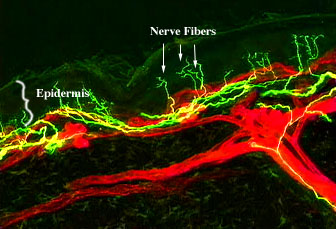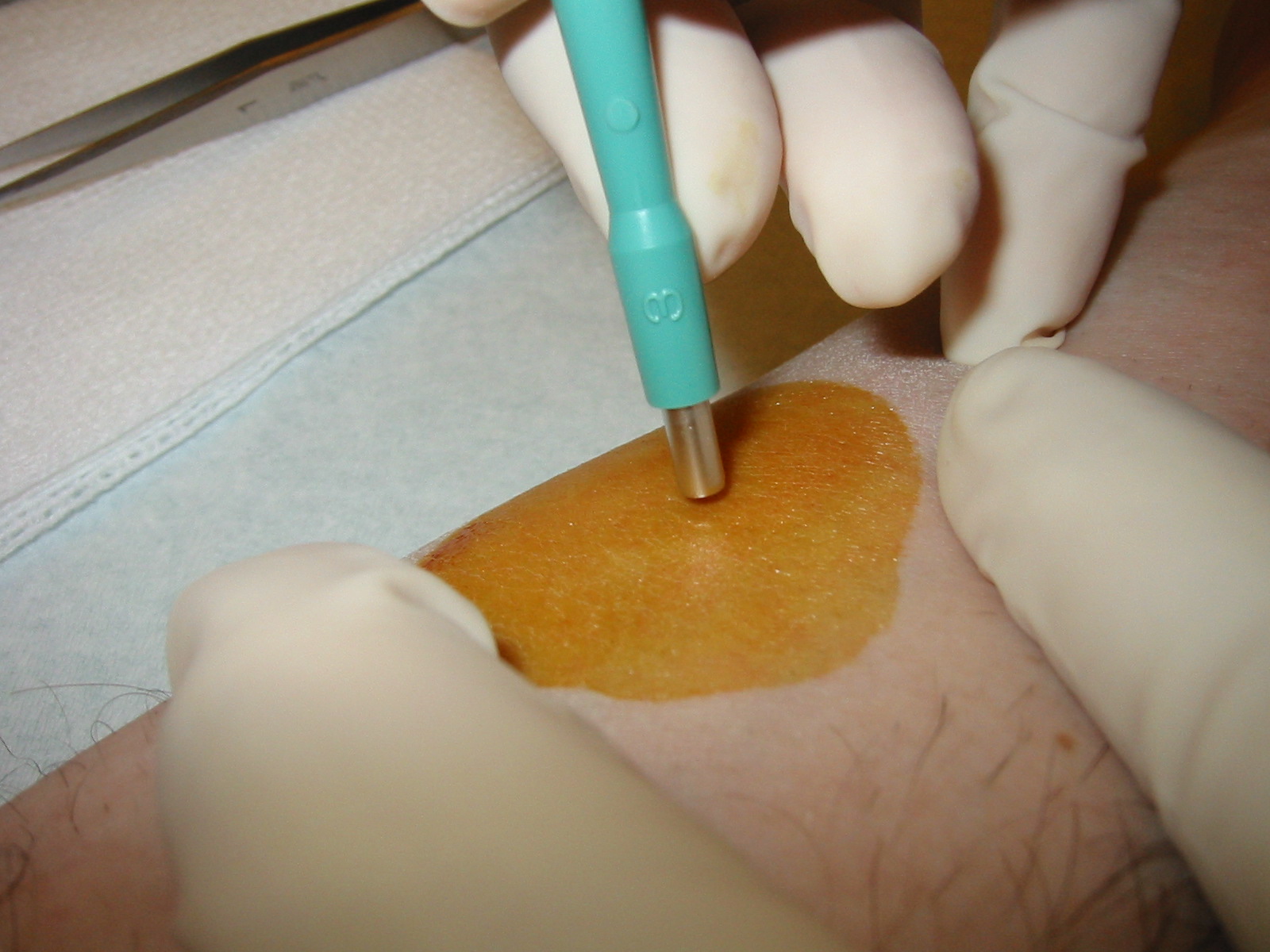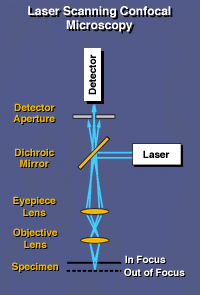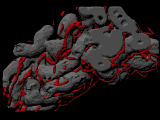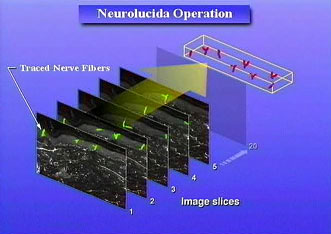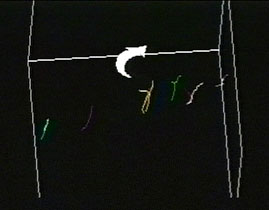Analysis of Nerves in a Skin Biopsy
We have developed methods to quantify peripheral neuropathy, especially diabetic and chemotherapy-induced neuropathy, and to determine if treatment of neuropathy objectively benefits the patient. The main symptom of neuropathy is sensory loss, usually called numbness: decreased ability sense touch, pain, warmth or cold. The nerve endings for these sensations are in the superficial layers of the skin. We sample these nerves by skin biopsy. A skin biopsy is about as big as the head of a match. It doesn't require sutures. We label the nerves with fluorescent antibodies so that we can see them either in a fluorescent microscope, or in a confocal microscope. The nerves are counted, then measured with a computer.
This is a section of a biopsy captured on a confocal microscope. The nerves, shown in green, almost reach the surface of the epidermis. Blood vessels are shown in red.
The Biopsy:
Obtaining a biopsy is a simple procedure. The site is anesthetized with lidocaine and a 2 to 3mm punch biopsy instrument is used to cut and extract the skin sample. The subject feels a slight pressure, but no pain. The sample is removed and preserved in a fixative. This wound does not require a suture; antibiotic ointment and a band-aid are sufficient.
Immunofluorescent Staining:
Nerves, capillaries, and basement membranes are localized by immunohistochemistry in our laboratory. Selected antibodies bind with high specificity to relevant proteins in the sectioned skin biopsy. Fluorescently-labeled secondary antibodies are then applied to the tissue sections and attach to the previously applied antibodies, forming labeled antibody complexes that can be observed with a fluorescent microscope. By using different antibodies that have been localized with distinct fluorescent dyes, multiple structures can be examined in the same section.
After the slides are stained, we view them with a fluorescent microscope. It uses a highly sensitive camera that collects images that can be recorded for image analysis and quatification of nerve fibers.
Confocal Microscopy:
A lot of our work is based on confocal microscopy where we collect a series of images (16 to 60) through a thick section of tissue -- much like a CT scan. Each image focuses on a thin plane of the tissue and eliminates out of focus blur. The susequent image series can be used to observe the nerve fibers with great precision. Visualization of three different molecules by triple staining is possible.
In the diagram, the beam of light reflects down through the objective lens to the sections. Photons from in-focus, fluorescent compounds reach the detector through a narrow aperture at the top. Out of focus photons strike the edge of the aperture. This results in sharply focused images of very thick sections. The light beam intensely illuminates the tissue from an individual depth in the tissue to create an optical section. It is then refocused deeper in the tissue for each additional optical section. Usually 16 to 60 optical sections (2um thick images) are collected. This is called a z-series. An entire z-series can be projected to give a 3-dimensional image of the relationship between nerves and adjacent tissue structures.
Quantification of Nerves in Sweat Glands:
Confocal images are obtained of sweat glands that have been triple-stained to visualize sweat tubules, capillaries, and the dense nerve supply. Using specialized computer software, the confocal z-series can be quantified by "paging" through the image series or by converting the stack to a 3D reconstruction for automated neuron tracing to derive surface areas and volumes of the capillaries and sweat tubules, and most importantly, of the nerves themselves.
Quantification of Nerves in the Epidermis:
This is a 3D view of nerves rising through the epidermis to the surface of the skin.
We use the Neurolucida software package from MicroBrightField to focus through the confocal images and trace the nerves in three dimensions (as shown in the diagram below).
These nerve tracings are combined into a model from which number of nerve structures, three dimensional length of each structure and number of branch points in each structure are derived. After the nerves are traced, this model can be visualized from any perspective.
